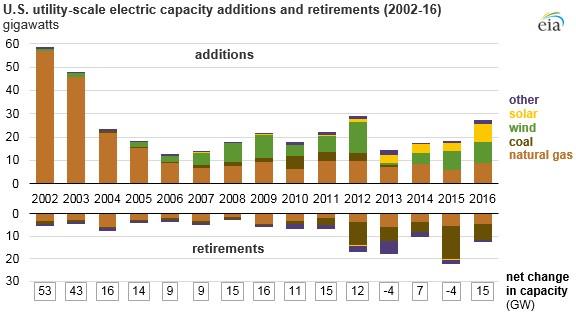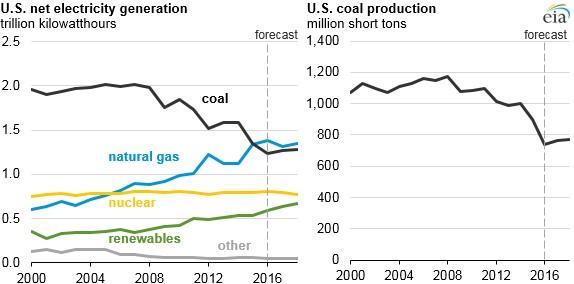Page added on August 27, 2017
The (Only) Culprit Of Coal’s Demise
Summary
On August 23, the U.S. Department of Energy released a highly anticipated study on the reliability of the U.S. electricity grid.
The DOE report concludes that far from becoming dangerously unstable, the electricity grid has “withstood a number of stresses”.
The greatest factor in the massive wave of coal and nuclear power plant closures has been cheap natural gas.
By Nick Cunningham
On August 23, the U.S. Department of Energy released a highly anticipated study on the reliability of the U.S. electricity grid, the product of a review ordered by Secretary of Energy Rick Perry back in April. The overarching conclusion from the nearly 200-page report? Cheap and abundant natural gas is the killer of coal plants, not renewables or excessive environmental regulation, as the U.S. President and many coal proponents have claimed.
The findings were notable because many energy analysts expected the report to offer a pretext for promoting the coal industry over other sources of generation while also slashing incentives for renewables. But not only did the report not explicitly recommend such a course of action, it laid the blame for the downfall of coal at the feet of natural gas, rather than on renewables or government policy.
To take one example, the DOE report concludes that far from becoming dangerously unstable, the electricity grid has “withstood a number of stresses,” and markets are “currently functioning as designed.” The agency did suggest that electricity markets might need to be reformed because as more renewable energy comes online, “with near-zero marginal costs,” it will “put additional economic pressure on revenues for traditional baseload resources.” In other words, solar and wind will cut into the financial viability of coal and nuclear power, forcing more and more plants to close down.
However, the greatest factor in the massive wave of coal and nuclear power plant closures has been cheap natural gas. The shale gas revolution has undercut the economics of older plants, and utilities are increasingly turning to gas, as well as solar and wind, when planning new capacity.
Just look at the data. In the past 15 years, nearly 230 gigawatts of new natural gas capacity was added, according to EIA data through the beginning of this year. It’s a staggering figure, one that exceeds the capacity of new coal (20 GW) over the same time frame by an order of magnitude. And to be sure, those coal additions were more than outweighed by amount of coal that was shut down (53 GW). In short, natural gas has eaten coal’s lunch. Renewables are now doing the same, and with no serious danger to grid reliability.

When Sec. Rick Perry ordered the study months ago, the premise of the report seemed to be that subsidies for renewable energy combined with stringent environmental regulation were distorting the market, undermining grid reliability. But the report concludes that these were only “secondary factors,” with cheap gas standing out as the overwhelming factor in coal’s demise.
Based on these conclusions, the report did not recommend putting in place any special incentives or handouts to keep coal and nuclear plants online. The DOE did suggest that baseload power – which it defines as coal and nuclear – should be compensated for the added reliability benefit it adds, suggesting that electricity pricing should be reformed. But the agency did not say that renewables are threatening grid stability.
This comes as a huge blow to owners of coal and nuclear power plants who had hoped that the Trump administration would take significant action to prop up their plants in the name of grid reliability. For now, it doesn’t look like that will be the case.
The report comes just days after a separate setback for the coal industry. The Trump administration earlier this week refused to take “emergency intervention” to prevent coal plants from closing, after coal executives pleaded for extraordinary action to save their industry. The AP reported that a coal producer and coal plant owner were seeking the intervention, warning that the company would slip into bankruptcy without federal help. But the Trump administration rebuffed them. The DOE said on August 22 that “the evidence does not warrant the use of this emergency authority.” That was echoed by a White House spokesperson who said it wouldn’t be “appropriate” to use an obscure authority to rescue coal plants.
CNN Money reported that a person familiar with the matter said: “It’s not an emergency to bail out one company.”
The publication of the DOE report, which essentially says the same thing in much more detail, suggests that the coal industry won’t receive a ton of help from the Trump administration, despite the president’s 2016 promise to coal miners to “get ready because you’re going to be working your asses off.”
The Trump administration has put the coal industry front and center as a symbol of restoring lost jobs, but it appears that the government won’t actually take extraordinary measures to rescue the industry.

Disclosure:I/we have no positions in any stocks mentioned, and no plans to initiate any positions within the next 72 hours.
5 Comments on "The (Only) Culprit Of Coal’s Demise"


John Kintree on Sun, 27th Aug 2017 8:36 am
Looking at the graph in the article, almost as much natural gas electricity generation capacity was retired in 2015 as was constructed.
In both 2015 and 2016, combined new generating capacity from wind and solar far exceeded new capacity from natural gas.
Kenz300 on Sun, 27th Aug 2017 9:50 am
Coal is dead money.
Smart money invests in the future not the past.
Jon Traudt on Mon, 28th Aug 2017 12:03 pm
Further reductions in the use of coal is good news. The American Lung Association estimates that inhalation of particles, including those from combustion of coal, have been causing about 200,000 premature deaths annually in the USA, in addition to damaging the cardiovascular, immune, respiratory, and central nervous systems of every person that is still breathing.
GregT on Mon, 28th Aug 2017 12:55 pm
Environmental Impacts of Natural Gas
“The drilling and extraction of natural gas from wells and its transportation in pipelines results in the leakage of methane, primary component of natural gas that is 34 times stronger than CO2 at trapping heat over a 100-year period and 86 times stronger over 20 years”
“Whether natural gas has lower life cycle greenhouse gas emissions than coal and oil depends on the assumed leakage rate, the global warming potential of methane over different time frames, the energy conversion efficiency, and other factors.”
http://www.ucsusa.org/clean-energy/coal-and-other-fossil-fuels/environmental-impacts-of-natural-gas
GregT on Mon, 28th Aug 2017 1:04 pm
Not to mention two other little factoids.
The burning of coal is masking climate change. If we stopped burning all coal tomorrow, global mean temperature would rise quickly, and considerably.
Natural gas is a fossil fuel, and is adding to the accumulation of greenhouse gasses in the environment. According to many studies, it adds more warming potential than both coal, and oil. Other than for economic reasons, burning natural gas does not solve anything, and in many respects, is a move in completely the wrong direction.